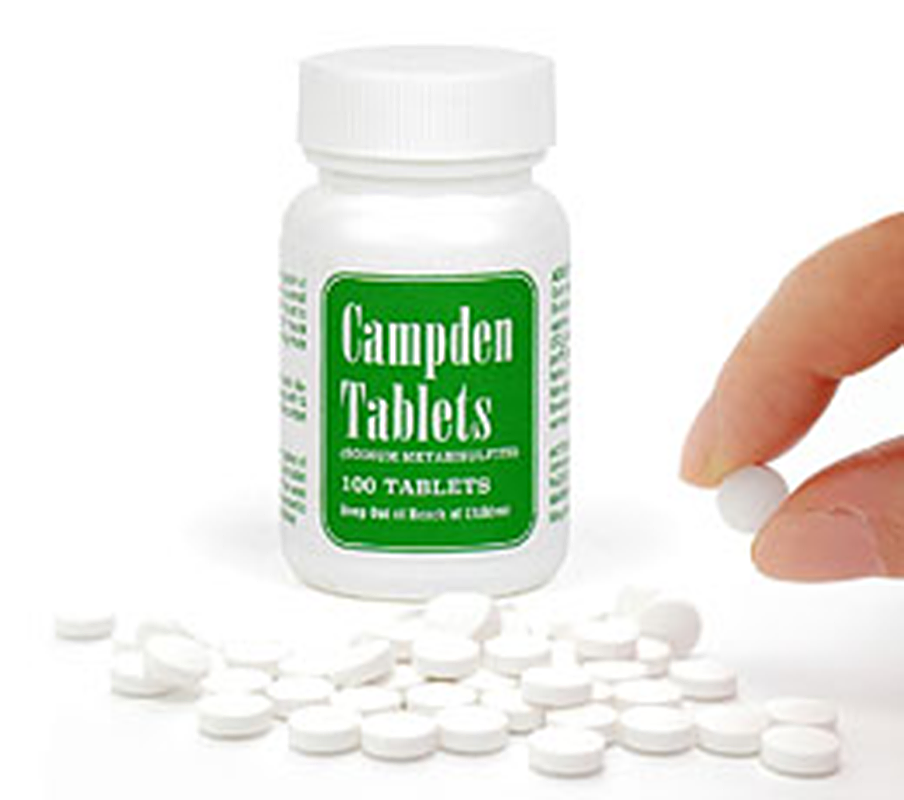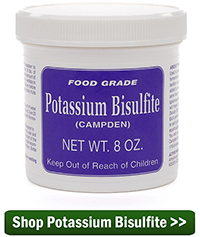 I crushed fresh Syrah juice from grapes last September into 3 six-gallon plastic fermenters w/air gaps. I added 1 Campden tablet per gallon into the 3 six gallon plastic fermenters 24 hr. before adding the wine yeast. I separated out the sediment in January. I plan to bottle in mid-May. From your guidance, I plan to add 1 Campden tab per gallon before bottling. Should I have also added Campden tabs when fermentation was finished in September? I tasted the wine in January and it tasted good.
I crushed fresh Syrah juice from grapes last September into 3 six-gallon plastic fermenters w/air gaps. I added 1 Campden tablet per gallon into the 3 six gallon plastic fermenters 24 hr. before adding the wine yeast. I separated out the sediment in January. I plan to bottle in mid-May. From your guidance, I plan to add 1 Campden tab per gallon before bottling. Should I have also added Campden tabs when fermentation was finished in September? I tasted the wine in January and it tasted good.
Name: Brad T.
State: California
—–
Hello Brad,
This is a great question about using Campden tablets in wine making. I’ll need to answer this from a couple of different perspectives…
When you add Campden tablets to a wine, your are essentially adding sulfites. Sulfites protect the wine by destroying any mold, bacteria or anything else that wants to grow in the wine. During the fermentation this is not a problem. It’s when the wine must is still and not fermenting that sulfites become important.
The issue is that over time the sulfites want to leave. They dissipate into the air as SO2 gas. For example, the Campden tablets you added before the fermentation are long-gone by the time the fermentation had ended. So there is a need to replenish the sulfites to help keep the wine protected.
From a winery’s point of view, you always want 40 to 70 PPM (parts-per-million) of sulfite in the wine after the fermentation. The winery will measure and maintain this level all the way through the clearing process and on to bottling. They can easily afford the time and effort to do this because a lot of wine is at stake.
From an individual winemaker’s point of view, it may be a little overkill to constantly test the sulfites and make adjustments as called for — particularly if you’re only making 5 or 6 gallons at a time, and you’re going to bottle the wine in a few weeks, anyway.
So as a compromise, I recommend using Campden tablets directly after the fermentation, then again, right before bottling. So to summarize, you are adding sulfites:
- 24 hours before fermentation
- After the fermentation
- Right before bottling.
By handling the wine in this way you can keep the wine more evenly protected without a lot of effort on your part with tests and measurements.
From a home winery’s point of view, say you are making 30, 50, 100 gallons, you may want to spend the time and energy to keep track of your sulfites. This can be done with Titret Test Vials and the Titret Hand Tool that works with it. By running this test you can determine the sulfites that are currently in your wine, in PPM, and how much you need to add, if any.
You may also want to switch to a Campden tablet substitute such as potassium metabisulfite or sodium metabisulfite. These both come in a granulated form. They add sulfites to the must or wine, just as Campden tablets, but they come in a granulated form. It’s much easier to use when needing larger amounts. Instead of crushing up a bunch of tablets, you just measure it out by the teaspoon.
This is the basics of using Campden tablets in your wine making. To delve a little deeper you might want to take a look at, Campden Tablets: What They Can And Can’t Do.
Happy Winemaking,
Ed Kraus
—–
Ed Kraus is a 3rd generation home brewer/winemaker and has been an owner of E. C. Kraus since 1999. He has been helping individuals make better wine and beer for over 25 years.

As a follow up to this when sulfating following the "Individual’s POV" should 1 Campden tablet (or equivalent) per gallon be used or con we go with a lower concentration?
Thank you.
We’ve been making wine for approx 2-3 summers. We are experiencing high acid levels at bottling time. We start out in the pH range of 3.2 to 3.4 and end up after fermentation and aging with a 2.8 to 2.4. Do you have any suggestions on what we are doing incorrectly. We do add a water and sugar syrup to mask the acid.
Scott, obviously you can put in 3 or 4 Campden tablets to a 5 gallon batch, but the result is very simple. The lower you keep the sulfite level in the wine, the more likely it could spoil. Not an issue, particularly if you drink your wine in 6 month or less, but for wines that might age 1.. 2.. 5 years, I would think twice before shorting the dosage.
Art, acid levels can change through the coarse of a fermentation. A lot of this has to do with what you are fermenting. You usually don’t see such a dramatic increase, but it can happen, particularly if you are fermenting concentrated juices that are not originally intended for making wine. You can get an excessive creation of succinic acid by the fermentation giving you lower pH readings.
are these question and answer fliers available in hard copy?
For articles like this one (and others), simply select and copy the entire page and paste it into a WORD.DOC. You can delete any of the information/ads you don’t want to keep.
Jerry, I am sorry but we do not have these articles in a ‘hard copy’ format.
I am new at winemaking. I just did a batch of pears but I did not put the campden tablets before putting the yeast. I intend to put the liquid into another fermenter. Would there be a problem to put the tablets before transferring? Thanks for some help.
Linette, the fact that you did not add Campden tablets before the fermentation does not guarantee that you will have a spoiled wine. In fact, since your fermentation started off successfully this tells me that there is very little chance of spoilage. Once the yeast take over a wine must and start fermenting, there next to no chance of things going south. So, there is no need to add Campden tablets at this point. Secondly, Campden tablets will interfere with the fermentation you’ve got going. They will kill some of the yeast. If you are relying on wild yeast (not recommended), Campden tablets can potentially kill all the yeast. With that being said, you will want to add Campden tablets after the fermentation has completed (verify with a hydrometer), and once again right before bottling the wine.
I am making my first 5 gallon batch of semi-sweet still mead. Starting gravity was 1.114 and now sits at 1.010, pH 3.3. It was in the fermenter for 21 days and fermentation had significantly slowed. I racked it into a 5 gal carboy and fermentation really picked back up. 7 days later, it has now nearly stopped (one bubble every 2-3 minutes) and the yeast settled out nicely. I racked it off into another carboy and topped it off. ABV is 14.1% and right on with my yeast tolerance and residual sugar is at about 2.5% according to my calc’s. I plan to monitor it until fermentation is complete and I verify it with another 1.010 SG reading. My plan is to leave this clear for another 3-4 weeks and then rack it off again and bulk age it. Should I add Campden tablets (1 for each gallon=5) now, or would it be all right to add it in a month when I rack for aging?
John, it is not necessary to add campden tablets between rackings. But if you decide to do so, I would add half the dose.
If the recommendation is to add campden tablets before bottling, how long before bottling do you do it? If you add the campden and stir/mix it with the wine, it would seem to me that you would need to wait to bottle my wine so that any residual settlement could occur.
Ron, you want to add the campden tablets and bottle immediately. To protect your wine, you want the sulfites trapped in the wine, waiting to bottle would allow for some of them to leave the wine. If you dissolve the tablets in water before adding to the wine and mix thoroughly, there should not be and sediment from the campden tablets.
In this post, you state to add campden or equivalent before and after fermentation and before bottling. I always do before fermentation, have never added after fermentation, but add before bottling.
For after fermentation is complete, is the standard dosage of 3-4 tablets a good number? I can’t find an reference to what is a correct amount for this stage of making the wine.
Rikk, we recommend adding the normal dosage of one tablet for each gallon of wine at all three of the stages of adding campden tablets.
My fruit wine is Done Fermenting and I would like to make champagne do I add the Camden tablets and rack The wine twice for clarity and then bottle it with yeast and sugar. Will the Camden tablet hinder fermentation in the bottle.
My fermentation has stopped on my tomato wine when I put my Camden tablets in do I leave the airlock off for 24 hours